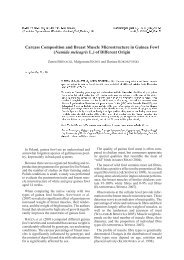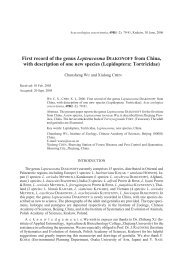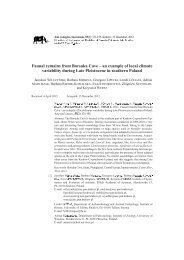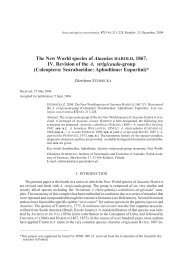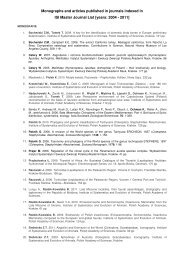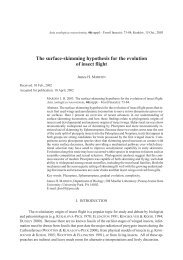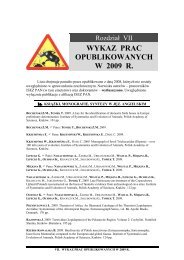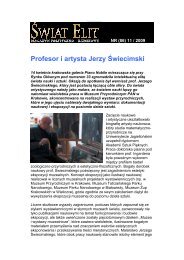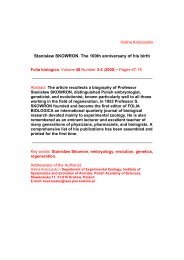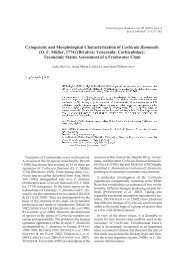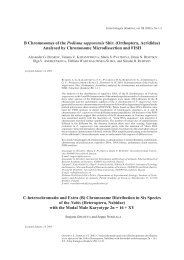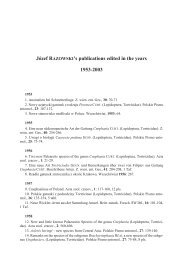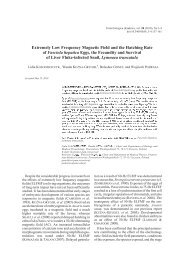Rafael Gioia MARTINS-NETO, Oscar Florencio GALLEGO
Rafael Gioia MARTINS-NETO, Oscar Florencio GALLEGO
Rafael Gioia MARTINS-NETO, Oscar Florencio GALLEGO
You also want an ePaper? Increase the reach of your titles
YUMPU automatically turns print PDFs into web optimized ePapers that Google loves.
Triassic insect fauna from South America<br />
249<br />
Etymology.Inhonor of Dr. Yuri POPOV (Russian Academy of Sciences), specialist<br />
on Hemiptera.<br />
Holotype. PULR-I nº 262, housed in PULR-I, Argentina. Type locality: Gualo, La<br />
Rioja Province, Argentina. Type stratum: Los Rastros Formation. Age: late Middle Triassic to early<br />
Late Triassic.<br />
Description.Fore wing 5 mm long. Costal margin curved, Apical margin rounded.<br />
Costal area very wide, broad at wing apex, narrowing slightly towards wing base. ScP origin at MP<br />
origin, long, oblique to Costal margin. RA relatively far from ScP, connected to RP by small crossvein.<br />
r-m at origin of RP+MP1. MP zigzag-like, three-branched: MP1 origin at RP origin; MP2 distally<br />
branched, connected to RP+MP1 by cross-vein, forming distal part of basal cell. Basal cell<br />
pentagonal, relatively small. Three cross-veins connect MP to CuA: m-cu1, the longer, at MP origin;<br />
m-cu2 continuous to r-m; and m-cu3 in mid length of CuA1. CuA two-branched: CuA1 distally<br />
branched and CuA2 unbranched. CuA2 distally connected to CuA1 through small cross-vein.<br />
Popovigocimex <strong>MARTINS</strong>-<strong>NETO</strong> &<strong>GALLEGO</strong> n. gen.<br />
Diagnosis.Similar to Archegocimex HANDLIRSCH, 1906, and Yurigocimex n. gen. by<br />
fore wing with small basal cell, and CuA zigzag-like. Similar to Yurigocimex n. gen. by ScP far<br />
from RA, differing however, by having two extra branches of RA. M connected to CuA by two<br />
cross-veins.<br />
Type species. Popovigocimex yurii <strong>MARTINS</strong>-<strong>NETO</strong> &<strong>GALLEGO</strong> n. sp., by present designation.<br />
Etymology.Inhonor of Dr. Yuri POPOV (Russian Academy of Sciences) and gocimex,<br />
from Archegocimex, the genus most similar. Gender: neutrum.<br />
Discussion.Popovigocimex n. gen. is similar to Archegocimex and Yurigocimex n.<br />
gen. by having a small basal cell and CuA zigzag-like, differing, however, by the shape of the basal<br />
cell (triangular in Archegocimex, pentagonal in Yurigocimex n. gen. and rectangular in Popovigocimex<br />
n. gen.). Popovigocimex n. gen. differs of all known Jurassic Progonomicidae genera (reviewed<br />
by POPOV &WOOTTON, 1977), by having ScP far from RA. In this aspect, Popovigocimex is similar<br />
to the Triassic genus Heteronella, differing however by having a small basal cell (absent in Heteronella<br />
as figured, or if existing, it is longer than in Popovigocimex). Popovigocimex n. gen.<br />
differs of Yurigocimex n. gen. by having two extra branches of RA (just one in Yurigocimex n. gen.),<br />
two cross-veins joining MP to CuA (three in Yurigocimex n. gen.),and CuA branches are longer,<br />
and not connected by a cross-vein.<br />
Popovigocimex yurii <strong>MARTINS</strong>-<strong>NETO</strong> &<strong>GALLEGO</strong> n. sp.<br />
Fig. 6F<br />
Diagnosis.Asforthegenus. MP2 distally unbranched.<br />
Etymology.Inhonor of Dr. Yuri POPOV (Russian Academy of Sciences), specialist on<br />
Hemiptera.<br />
Holotype.PULR-I nº 271, housed in PULR-I, Argentina. Type locality: Gualo, La<br />
Rioja Province, Argentina. Type stratum: Los Rastros Formation. Age: late Middle Triassic to early<br />
Late Triassic.<br />
Description.Fore wing 4 mm long. Costal margin curved, Apical margin rounded.<br />
Costal area very wide, broad at wing apex, narrowing slightly towards wing base. ScP origin anterior<br />
to MP origin, long, oblique to Costal margin. RA three-branched. MP two-branched: MP1 origin<br />
at the RP origin, MP2 unbranched, connected to RP+MP1 by cross-vein, forming distal part of<br />
basal cell. Basal cell rectangular, relatively small. Two cross-veins connecting MP to CuA: m-cu1,<br />
smaller, at MP1+RP origin, and m-cu2 close to apex. CuA two-branched: CuA1 and CuA2 unbranched,<br />
as preserved. Two cross-veins preserved, probable connected to CuP (not preserved).



